lock MAZDA PROTEGE 1992 Workshop Manual
[x] Cancel search | Manufacturer: MAZDA, Model Year: 1992, Model line: PROTEGE, Model: MAZDA PROTEGE 1992Pages: 1164, PDF Size: 81.9 MB
Page 5 of 1164
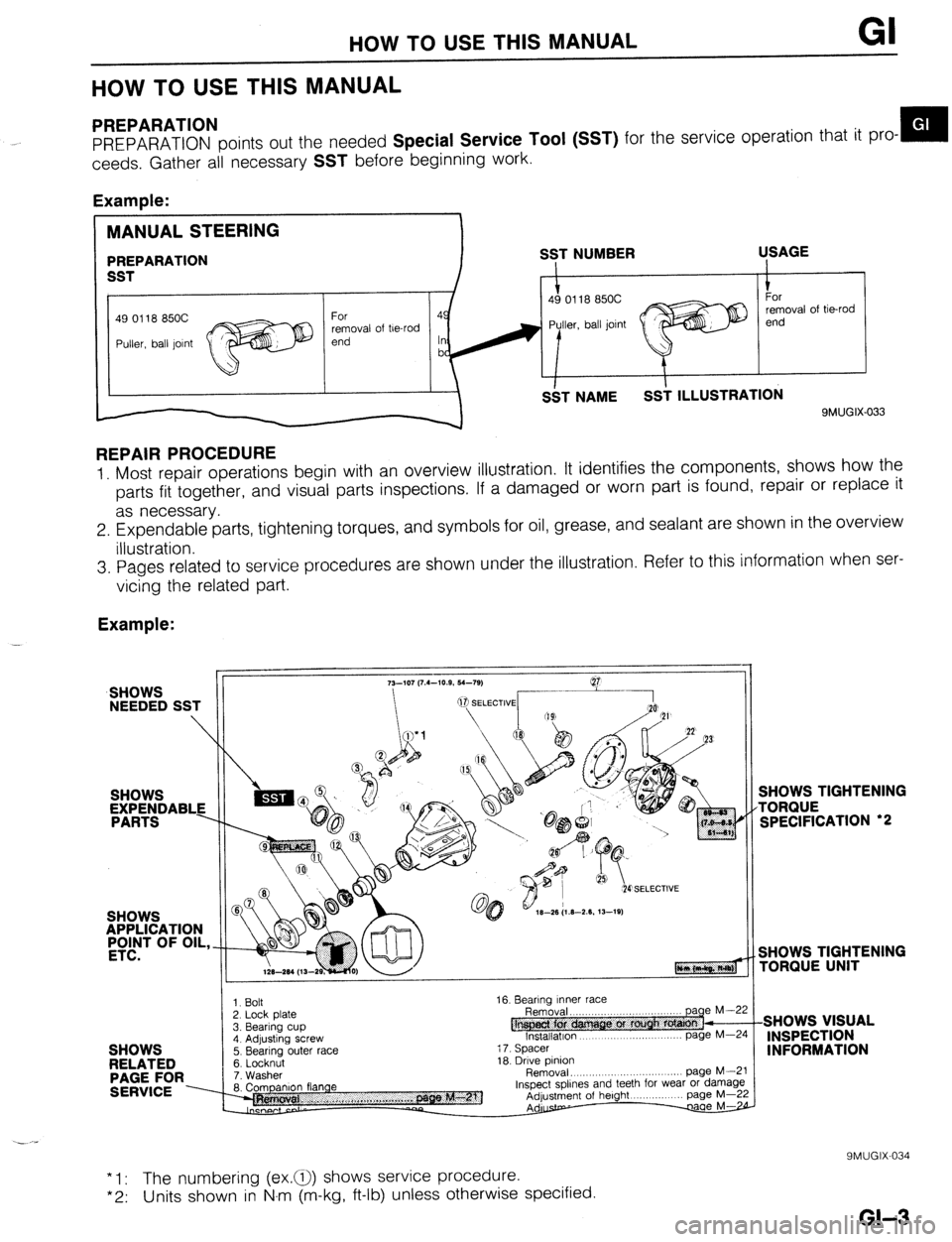
HOW TO USE THIS MANUAL GI
HOW TO USE THIS MANUAL
PREPARATION
PREPARATION points out the needed Special Service Tool (SST) for the service operation that it pro- m
ceeds. Gather all necessary
SST before beginning work.
Example:
49 0118 850C
removal of be-rod
9MUGIX-033
REPAIR PROCEDURE
1. Most repair operations begin with an overview illustration. It identifies the components, shows how the
parts fit together, and visual parts inspections. If a damaged or worn part is found, repair or replace it
as necessary.
2. Expendable parts, tightening torques, and symbols for oil, grease, and sealant are shown in the overview
illustration.
3. Pages related to service procedures are shown under the illustration. Refer to this information when ser-
vicing the related part.
Example:
SHOWS
NEEDED SST
SHOWS
APPLICATION
#T OF OIL,
SHOWS
RELATED
PAGE FOR
SERVICE ----
3. Bearing cup 1. Bolt
2. Lock Dlate
4. Adjusting screw
5. Bearing outer race
6. Locknut
7. Washer
8. Companion flange 16. Bearing Inner race
@ Removal. ,,,..,,,..
lnstallatlon page
page M--5 M-Z
i 7. Spacer
18. Drive pinion
Removal, .,,, ,.,, .,......... page M--i
Inspect spllnes and teeth for wear or damagl
Adjustment of height page M-2
Adurstp- w
SHOWS TIGHTENING
TORQUE
SPECIFICATION ‘2
SHOWS TIGHTENING
rORQlJE UNIT
SHOWS VISUAL
INSPECTION
INFORMATION
* 1: The numbering (ex.a) shows service procedure.
*2: Units shown in N.m (m-kg, ft-lb) unless otherwise specified.
9MUGIX-034
GI-3
Page 7 of 1164

FUNDAMENTALPROCEDURES GI
SMUGIX-0: B
47UOGX-00 5 ‘3
16
A WORD ABOUT SAFETY
The following precautions must be followed when jacking up
the vehicle.
1. Block the wheels.
2. Use only the specified jacking positions.
3. Support the vehicle with safety stands.
Start the engine only after making certain the engine compart-
ment is clear of tools and people.
PREPARATION OF TOOLS AND MEASURING
EQUIPMENT
Be sure that all necessary tools and measuring equipment are
available before starting any work.
SPECIAL TOOLS
Use special tools when they are required.
REMOVAL OF PARTS
While correcting a problem, try also to determine its cause.
Begin work only after first learning which parts and subassem-
blies must be removed and disassembled for replacement or
repair.
DISASSEMBLY
If the disassembly procedure is complex, requiring many parts
to be disassembled, all parts should be disassembled in a way
that will not affect their performance or external appearance
and identified so that reassembly can be performed easily and
efficiently.
GI-5
Page 8 of 1164

GI FUNDAMENTAL PROCEDURES
9MUGIX-04t 3
9MUGIX-041
9MUGIX.004
I
Depending on location:
1. Inspection of parts
When removed, each part should be carefully inspected for
malfunctioning, deformation, damage, and other problems.
2. Arrangement of parts
All disassembled parts should be carefully arranged for re-
assembly.
Be sure to separate or otherwise identify the parts to be
replaced from those that will be reused.
3. Cleaning parts for reuse
All parts to be reused should be carefully and thoroughly
cleaned in the appropriate method.
REASSEMBLY
Standard values, such as torques and certain adjustments,
must be strictly observed in the reassembly of all parts.
Refer to STANDARD BOLT AND NUT TIGHTENING TORQUE
in Section TD for tightening torques not mentioned in the main
text.
If removed, these parts should be replaced with new ones:
1. Oil seals 2. Gaskets
3. O-rings 4. Lock washers
5. Cotter pins 6. Nylon nuts
1. Sealant should be applied or new gaskets used.
2. Oil should be applied to the moving components of parts.
3. Specified oil or grease should be applied at the prescribed
locations (such as oil seals) before reassembly.
I
23lJGIX.004
GI-6
Page 13 of 1164
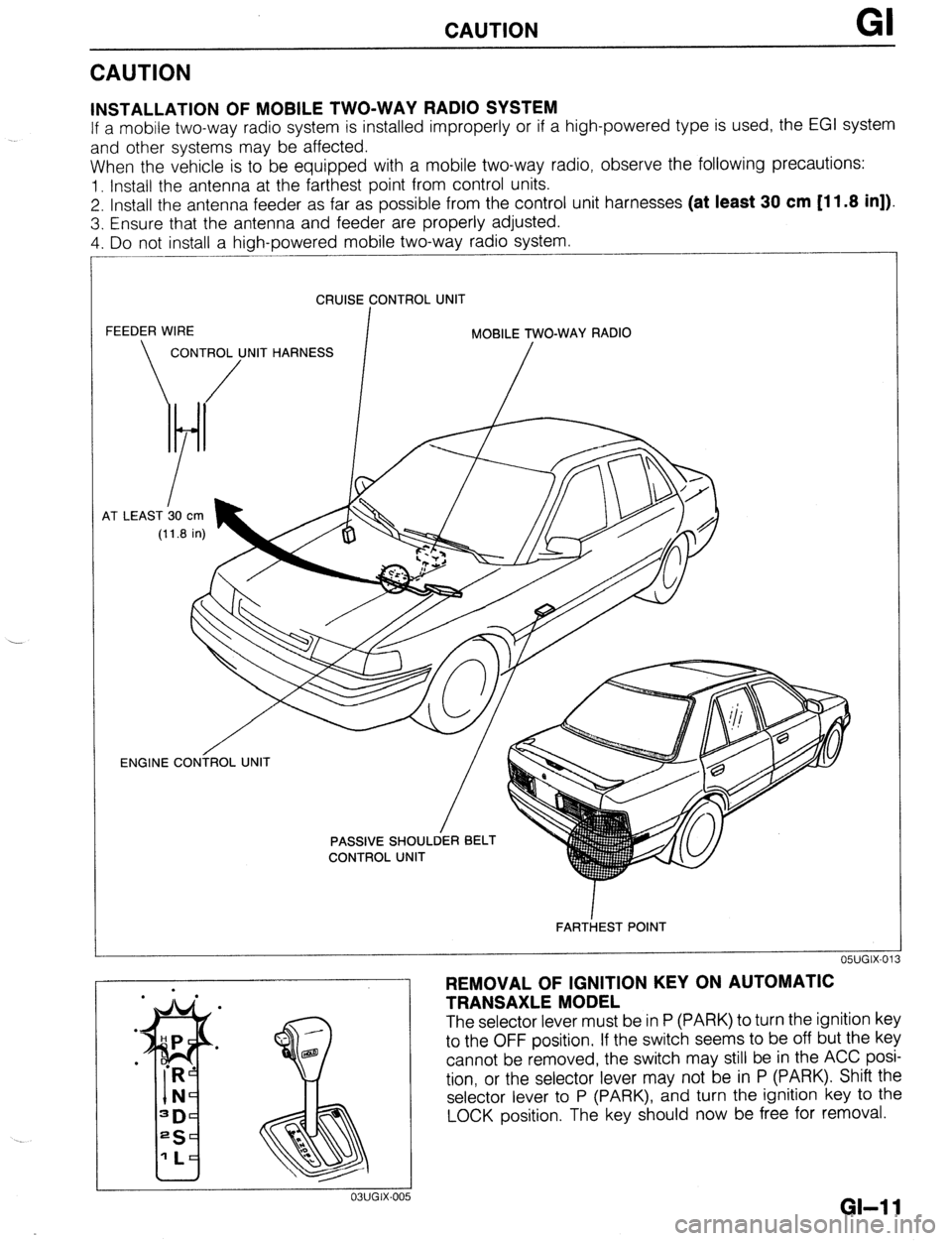
CAUTION GI
CAUTION
INSTALLATION OF MOBILE TWO-WAY RADIO SYSTEM
If a mobile two-way radio system is installed improperly or if a high-powered type is used, the EGI system
and other systems may be affected.
When the vehicle is to be equipped with a mobile two-way radio, observe the following precautions:
1. Install the antenna at the farthest point from control units.
2. Install the antenna feeder as far as possible from the control unit harnesses (at least 30 cm [11.8 in]).
3. Ensure that the antenna and feeder are properly adjusted.
4. Do not install a high-powered mobile two-way radio system.
CRUISE CONTROL UNIT
FEEDER WIRE
I MOBILE TWO-WAY RADIO
CONTROL UNIT HARNESS
/ /
4T LEAST b0
cm
(11.8 in)
OWGIX-013 ENGINE CONiROL UNIT
/
FARTiEST POINT
REMOVAL OF IGNITION KEY ON AUTOMATIC
TRANSAXLE MODEL
The selector lever must be in P (PARK) to turn the ignition key
to the OFF position. If the switch seems to be off but the key
cannot be removed, the switch may still be in the ACC posi-
tion, or the selector lever may not be in P (PARK). Shift the
selector lever to P (PARK), and turn the ignition key to the
LOCK position. The key should now be free for removal.
GI-1 1
Page 15 of 1164
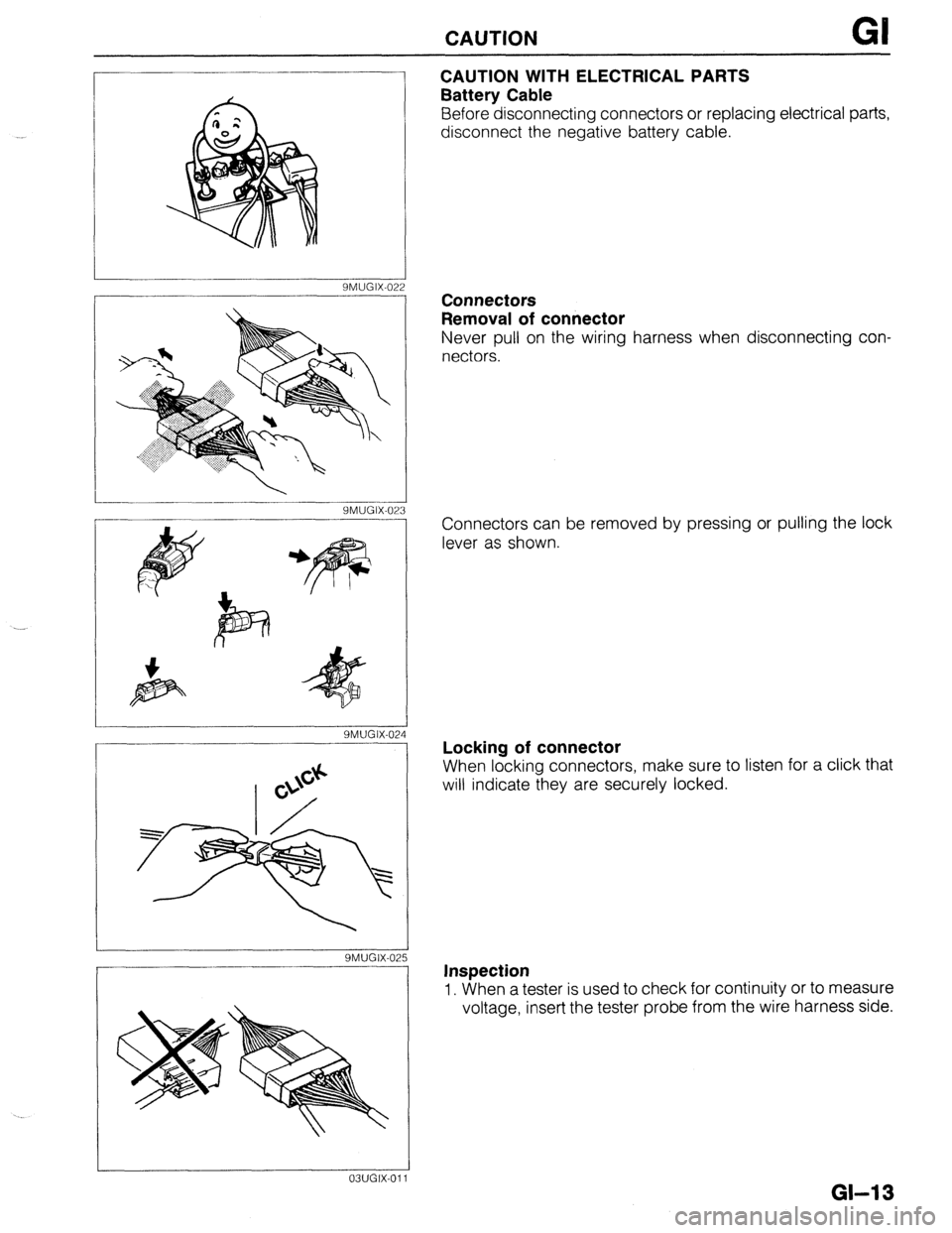
. .-
CAUTION Gl
CAUTION WITH ELECTRICAL PARTS
Battery Cable
Before disconnecting connectors or replacing electrical parts,
disconnect the negative battery cable.
SMUGIX-022
YMUGIX-023
SMUGIX-02
SMUGIX-02
03UGIX-011 Connectors
Removal of connector
Never pull on the wiring harness when disconnecting con-
nectors.
Connectors can be removed by pressing or pulling the lock
lever as shown.
Locking of connector
When locking connectors, make sure to listen for a click that
will indicate they are securely locked.
Inspection
1. When a tester is used to check for continuity or to measure
voltage, insert the tester probe from the wire harness side.
GM 3
Page 16 of 1164
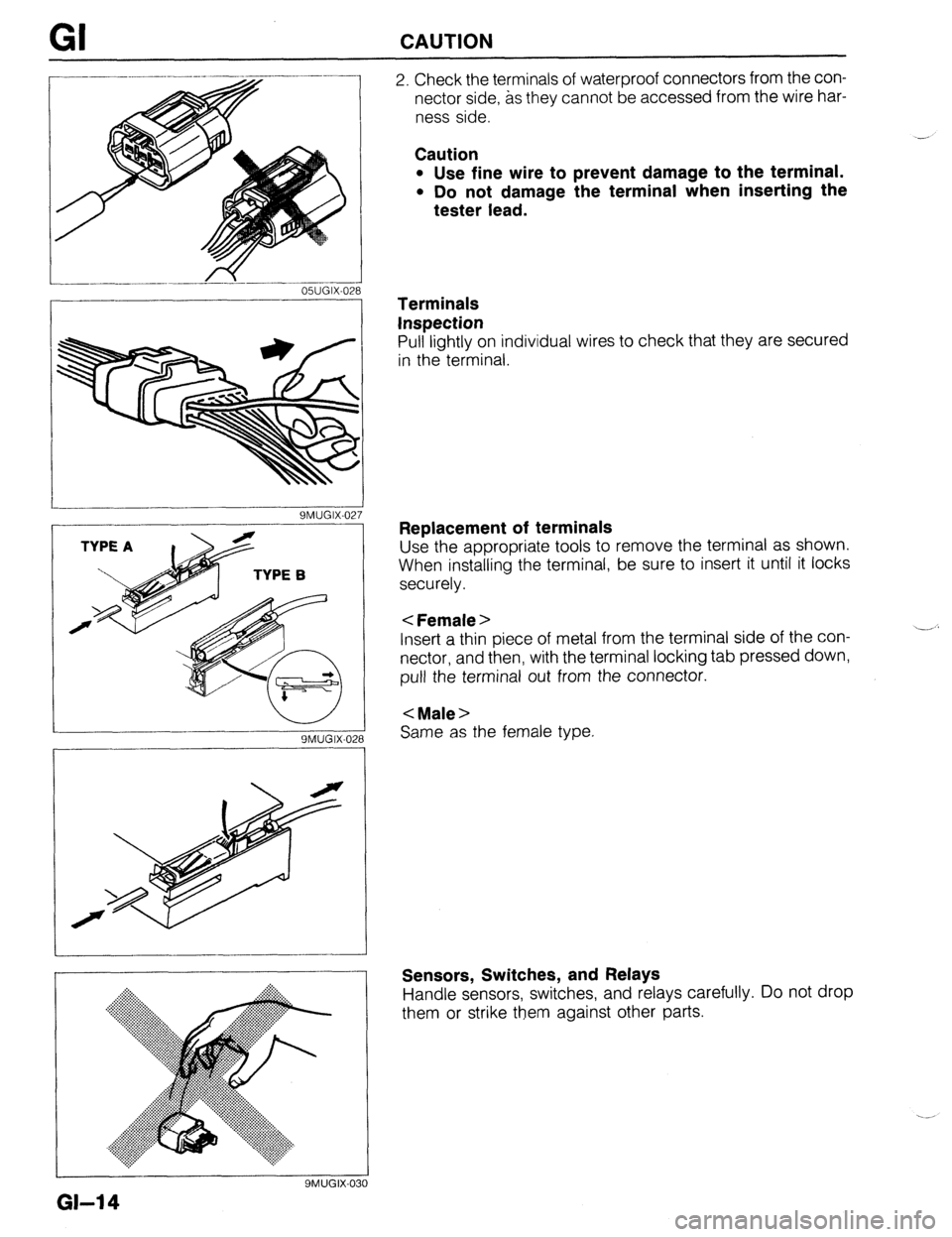
GI CAUTION
/
_____--__.. -I
OWGIX-028
2. Check the terminals of waterproof connectors from the con-
nector side, as they cannot be accessed from the wire har-
ness side.
Caution
l Use fine wire to prevent damage to the terminal.
l Do not damage the terminal when inserting the
tester lead.
.- - 9MUGIX-027
9MUGIX-028
Same as the female type.
I
9MUGK031
Terminals
Inspection
Pull lightly on individual wires to check that they are secured
in the terminal.
Replacement of terminals
Use the appropriate tools to remove the terminal as shown.
When installing the terminal, be sure to insert it until it locks
securely.
< Female >
Insert a thin piece of metal from the terminal side of the con-
nectar, and then, with the terminal locking tab pressed down,
pull the terminal out from the connector.
< Male >
Sensors, Switches, and Relays
Handle sensors, switches, and relays carefully. Do not drop
them or strike them against other parts.
GI-14
Page 20 of 1164
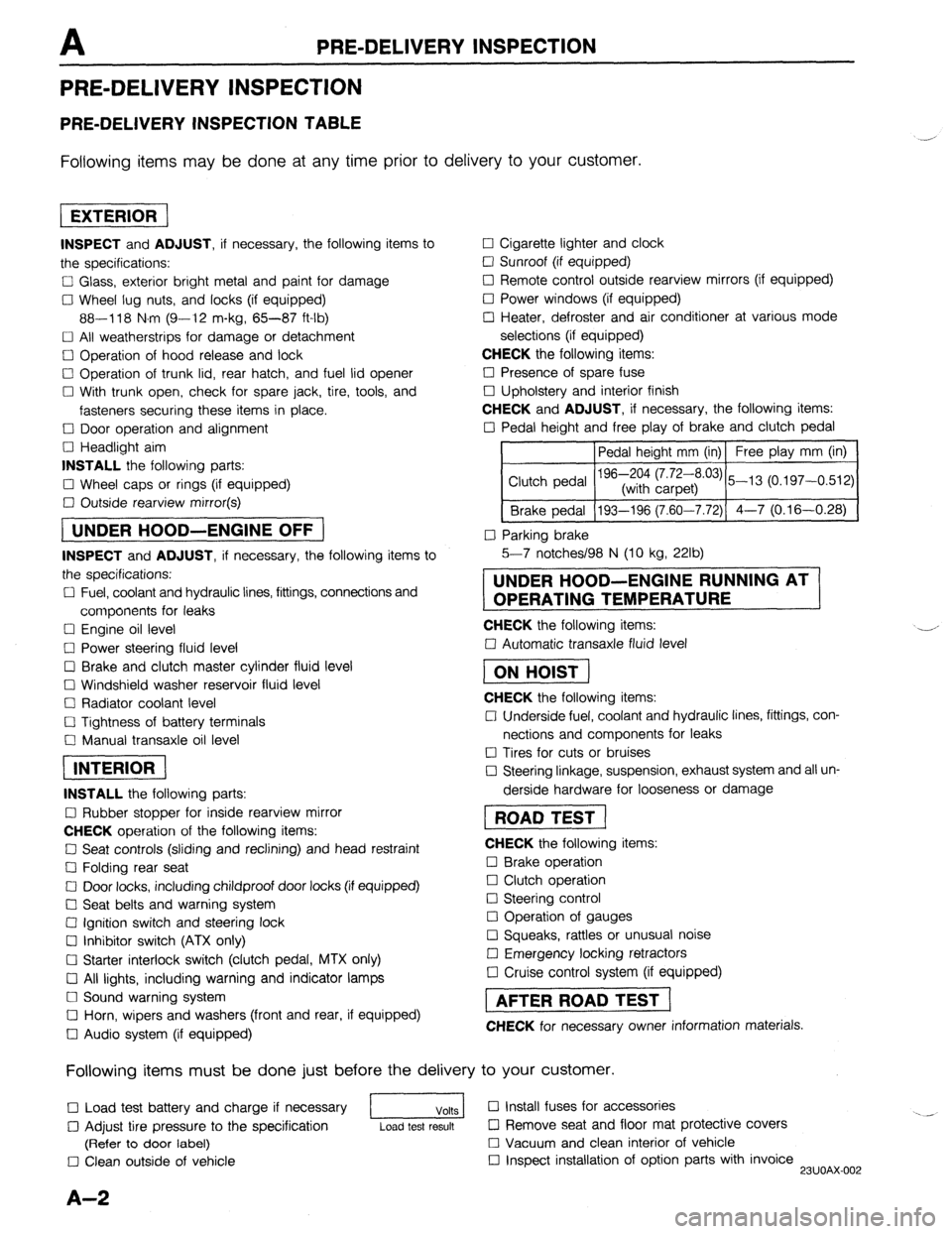
PRE-DELIVERY INSPECTION
PRE-DELIVERY INSPECTION
PRE-DELIVERY INSPECTION TABLE
Following items may be done at any time prior to delivery to your customer.
INSPECT and ADJUST, if necessary, the following items to
the specifications:
0 Glass, exterior bright metal and paint for damage
Cl Wheel lug nuts, and locks (if equipped)
88-118 N.m (9-12 m-kg, 65-87 ft-lb)
q All weatherstrips for damage or detachment
0 Operation of hood release and lock
0 Operation of trunk lid, rear hatch, and fuel lid opener
Cl With trunk open, check for spare jack, tire, tools, and
fasteners securing these items in place.
Cl Door operation and alignment
Cl Headlight aim
INSTALL the following parts:
Cl Wheel caps or rings (if equipped)
q Outside rearview mirror(s)
1 UNDER HOOD-ENGINE OFF )
INSPECT and ADJUST, if necessary, the following items to
the specifications:
0 Fuel, coolant and hydraulic lines, fittings, connections and
components for leaks
Cl Engine oil level
0 Power steering fluid level
0 Brake and clutch master cylinder fluid level
El Windshield washer reservoir fluid level
Cl Radiator coolant level
Cl Tightness of battery terminals
Cl Manual transaxle oil level
riizmiq
INSTALL the following parts:
Cl Rubber stopper for inside rearview mirror
CHECK operation of the following items:
0 Seat controls (sliding and reclining) and head restraint
Cl Folding rear seat
0 Door locks, including childproof door locks (if equipped)
Seat belts and warning system
Cl Ignition switch and steering lock
0 Inhibitor switch (ATX only)
U Starter interlock switch (clutch pedal, MTX only)
Cl All lights, including warning and indicator lamps
Cl Sound warning system
Cl Horn, wipers and washers (front and rear, if equipped)
0 Audio system (if equipped) 0 Cigarette lighter and clock
0 Sunroof (if equipped)
II Remote control outside rearview mirrors (if equipped)
Cl Power windows (if equipped)
q Heater, defroster and air conditioner at various mode
selections (if equipped)
CHECK the following items:
Cl Presence of spare fuse
0 Upholstery and interior finish
CHECK and ADJUST, if necessary, the following items:
0 Pedal height and free play of brake and clutch pedal
Pedal height mm (in) Free play mm (in)
0 Parking brake
5-7 notches/98 N (10 kg, 22lb)
UNDER HOOD-ENGINE RUNNING AT
OPERATING TEMPERATURE
CHECK the following items:
q Automatic transaxle fluid level
[I
CHECK the following items:
Cl Underside fuel, coolant and hydraulic lines, fittings, con-
nections and components for leaks
0 Tires for cuts or bruises
0 Steering linkage, suspension, exhaust system and all un-
derside hardware for looseness or damage
[I
CHECK the following items:
0 Brake operation
0 Clutch operation
Cl Steering control
Cl Operation of gauges
q Squeaks, rattles or unusual noise
Cl Emergency locking retractors
0 Cruise control system (if equipped)
1 AFTER ROAD TEST (
CHECK for necessary owner information materials.
Following items must be done just before the delivery to your customer.
q Load test battery and charge if necessary
1 Volts 1 0 Install fuses for accessories
i.. _
0 Adjust tire pressure to the specification
Load test result cl Remove seat and floor mat protective covers
(Refer to door label) 0 Vacuum and clean interior of vehicle
0 Clean outside of vehicle q Inspect installation of option parts with invoice
23UOAX-002
A-2
Page 28 of 1164
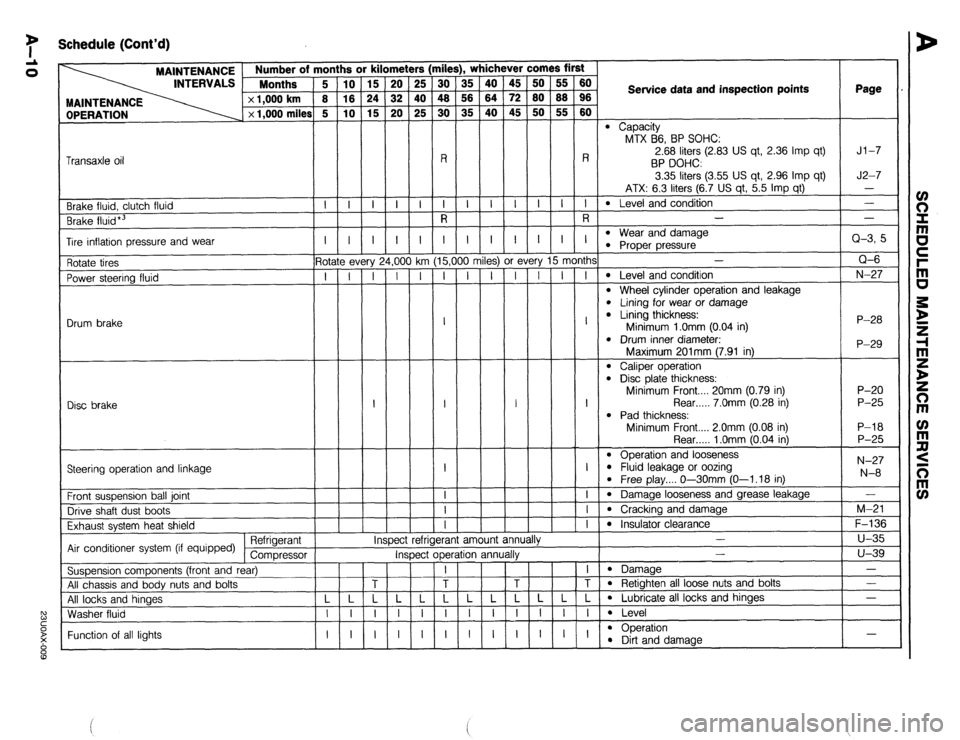
7 Schedule (Cont’d)
rile
iii
48
30
-
R
I
R !rs
25
40
25
-
-i- , whichever comes first
OPERATION MAINTENANCE Number of m
INTERVALS Months
x 1,000 km
x 1,000 miles
ii
is
G
-
i-
-
-
I
5-
T
-
-
-
-
-
-
- ii
z
ro
-
I-
-
-
I
- 45
72
45
-
-i-
-
-
I
-
ry 15 month:
I I I
A
t
A
j
milt Service data and inspection points Page
l Capacity
MTX B6, BP SOHC:
2.68 liters (2.83 US qt, 2.36 Imp qt)
BP DOHC
3.35 liters (3.55 US qt, 2.96 Imp qt)
ATX: 6.3 liters (6.7 US qt, 5.5 Imp qt)
l Level and condition
- Jl-7
J2-7
- Transaxle oil
l Wear and damaae -i- -i- -i- -
Brake fluid, clutch fluid
Brake fluid*3 -
Q-3, 5
Q-6
N-27
P-28
P-29 I I
- I
1,oo
-i
-
-
-
-
-
-
- I
G
T
-
-
-
-
-
-
- I
15,(
I Tire inflation pressure and wear l Proper pressure-
-
l Level and condition
l Wheel cylinder operation and leakage l Lining for wear or damage l Lining thickness:
Minimum 1 .Omm (0.04 in)
l Drum inner diameter. 3s) or f
I I
I
:t r
- Rotate tires
Power steering fluid
Drum brake ? every
I I
Disc brake I I
Maximum 201mm (7.91 in)
l Caliper operation l Disd plate thickness:
Minimum Front.... 20mm (0.79 in)
Rear . . . . . 7.0mm (0.28 in)
l Pad thickness:
Minimum Front.... 2.0mm (0.08 in) P-20
P-25
P-l 8
P-25
N-27
N-8 Rear . . . . . 1 .Omm (0.04 in)
l Operation and looseness l Fluid leakage or oozina
l Free play.... O--3OmmjO-1.18 in)
l Damage looseness and grease leakage
l Cracking and damage
l Insulator clearawp .-v
-
Steering operation and linkage
I
-i-
-I-
-i- Front suspension ball joint
Drive shaft dust boots
Exhaust system heat shield
Air conditioner system (if equipped) Refrigerant
Compressor
Suspension components (front and rear)
All chassis and body nuts and bolts
All locks and hinaes
Washer fluid -
M-21
F-136
u-35
u-39
-
- IY efrigerant amount ann
*. I# mspec
Inspect operation annualry -
l Damaae
l Retighten all loose nuts and bolts
l Lubricate all locks and hinges
l Level
l ODeration - Function of all lights l !%t and damage -
Page 31 of 1164

Bl
ENGINE
(SOHC)
INDEX .......................................... Bl- 2
OUTLINE ...................................... Bl- 3
SPECIFICATIONS ........................
Bl- 3
TROUBLESHOOTING GUIDE ..........
Bl- 3
ENGINE TUNE-UP PROCEDURE ......
Bl- 5
PREPARATION ............................ Bl- 5
ENGINE OIL ............................... Bl- 5
ENGINE COOLANT.. ....................
Bl- 5
DRIVE BELT ............................... Bl- 5
HLA .......................................... Bl- 7
IGNITION TIMING, IDLE SPEED
..... Bl- 8
COMPRESSION ............................. Bl-10
INSPECTION ............................... 81-10
ON-VEHICLE
MAINTENANCE.. ........
Bl-1 1
PREPARATION ............................ Bl-11
TIMING BELT .............................. Bl-12
CYLINDER
HEAD GASKET ........... Bl-16
HLA .......................................... Bl-20
FRONT OIL SEAL.. ...................... 81-23
REAR OIL SEAL ..........................
Bl-25
REMOVAL ..................................... 81-28
PROCEDURE .............................. Bl-28
ENGINE STAND MOUNTING.. .........
Bl-35
PREPARATION
............................ 81-35
PROCEDURE ..............................
Bl-36
DISASSEMBLY .............................. Bl-38
PREPARATION ............................ Bl-38
AUXILIARY PARTS.. ..................... 81-40
TIMING BELT .............................. 81-41
CYLINDER HEAD.. ......................
81-43
CYLINDER BLOCK
(EXTERNAL PARTS)
................... 81-47
CYLINDER BLOCK
(INTERNAL
PARTS). ................... Bl-50 INSPECTION /
REPAIR.. .................
81-54
PREPARATION ............................ Bl-54
CYLINDER HEAD.. ...................... Bl-54
VALVE
MECHANISM.. .................. Bl-55
CAMSHAFT ................................ 81-58
HLA .......................................... Bl-60
CYLINDER BLOCK ......................
Bl-60
OIL JET ..................................... Bl-61
PISTON, PISTON RING, AND
PISTON PIN .............................. Bl-62
CONNECTING ROD.. ...................
Bl-63
CRANKSHAFT ............................ Bl-64
BEARING ................................... 81-64
TIMING BELT .............................. Bl-65
TENSIONER,
IDLER.. ................... 81-65
TENSIONER SPRING ...................
81-65
PULLEY ..................................... Bl-65
ASSEMBLY ................................... Bl-66
PREPARATION ............................ Bl-66
CYLINDER BLOCK
(INTERNAL PARTS). ................... Bl-68
CYLINDER BLOCK
(EXTERNAL PARTS) ...................
Bl-74
CYLINDER
HEAD.. ...................... 81-79
TIMING BELT .............................. Bl-86
AUXILIARY
PARTS.. ..................... Bl-89
ENGINE STAND DISMOUNTING.. .... Bl-92
PROCEDURE .............................. 81-92
INSTALLATION ............................. 81-94
PROCEDURE .............................. Bl-94
23UOBl-001
Page 37 of 1164
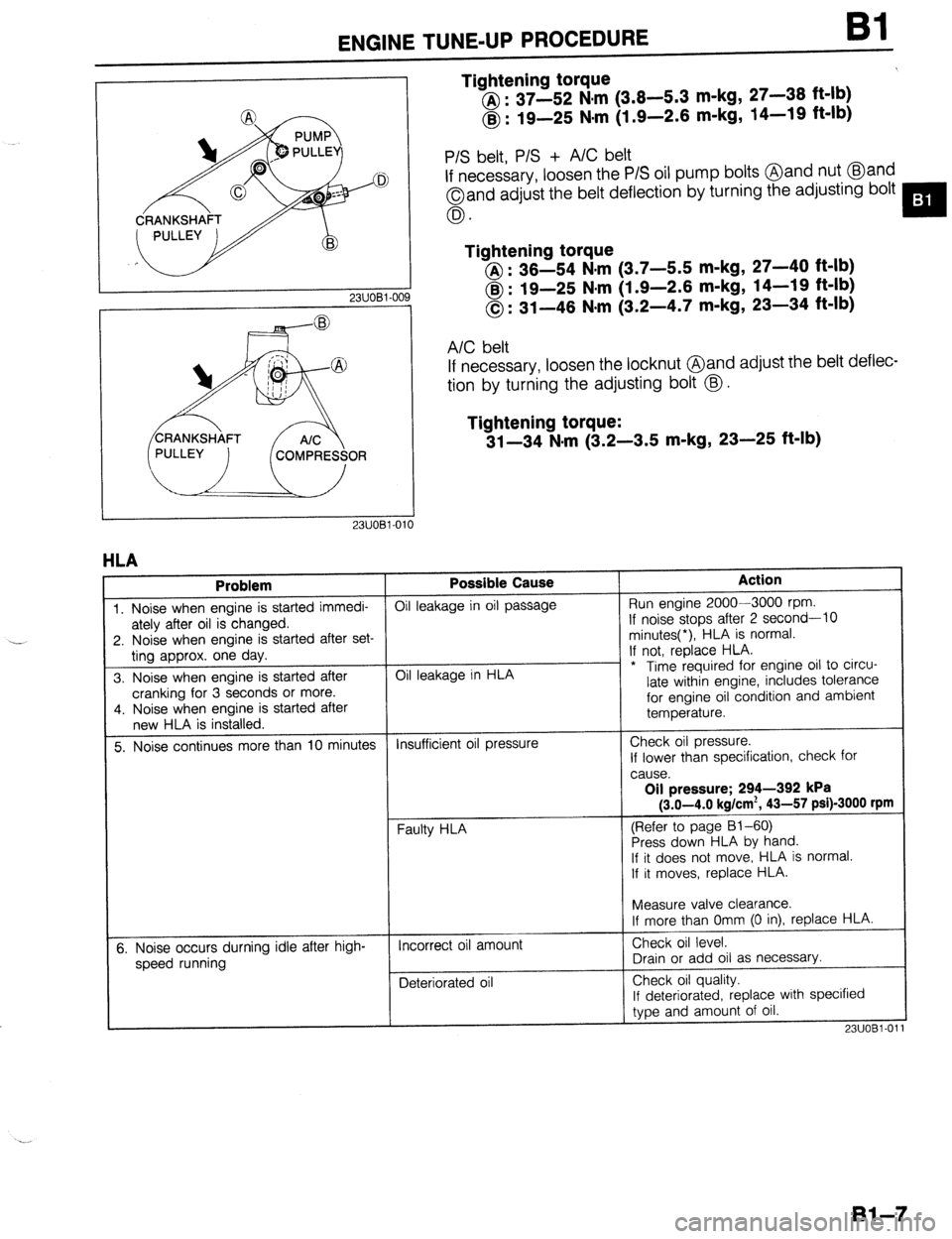
ENGINE TUNE-UP PROCEDURE Bl
Tightening torque
@ : 37-52 N,m (3.8-5.3 m-kg, 27-38 ft-lb)
@ : 19-25 Nsm (1.9-2.6 m-kg, 14-19 ft-lb)
23UOBl-OC
P/S belt, P/S + A/C belt
If necessary, loosen the P/S oil pump bolts @and nut @and
Oand adjust the belt deflection by turning the adjusting bolt
0.
Tightening torque
@I : 36-54 N.m (3.7-5.5 m-kg, 27-40 ft-lb)
@ : 19-25 N#m (1.9-2.6 m-kg, 14-19 ft-lb)
0: 31-46 N-m (3.2-4.7 m-kg, 23-34 ft-lb)
A/C belt
If necessary, loosen the locknut @and adjust rhe belt deflec-
tion by turning the adjusting bolt @.
Tightening torque:
31-34 N-m (3.2-3.5 m-kg, 23-25 ft-lb)
1
HLA
Problem Possible Cause Action
1. Noise when engine is started immedi- Oil leakage in oil passage Run engine 2000-3000 rpm.
ately after oil is changed. If noise stops after 2 second-10
2. Noise when engine is started after set- minutes(*), HLA is normal.
ting approx. one day. If not, replace HLA.
3. Noise when engine is started after Oil leakage in HLA - * Time required for engine oil to circu-
cranking for 3 seconds or more. late within engine, includes tolerance
4. Noise when engine is started after for engine oil condition and ambient
new HLA is installed. temperature.
5. Noise continues more than 10 minutes Insufficient oil pressure Check oil pressure.
If lower than specification, check for
cause.
Oil pressure; 294-392 kPa
(3.0-4.0 kg/cm*, 43-57 psi)-3000 rpm
(Refer to page 81-60)
Press down HLA by hand.
If it does not move,. HLA is normal.
If it moves, replace HLA.
t
I
Measure valve clearance.
If more than Omm (0 in), replace HLA.
5. Noise occurs durning idle after high-
speed running Incorrect oil amount
Deteriorated oil Check oil level.
Drain or add oil as necessary.
Check oil quality.
If deteriorated, replace with specified
type and amount of oil.
23UOBl-01
Bl-7